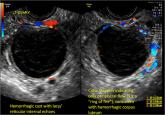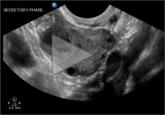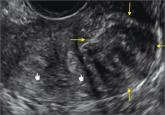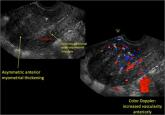News

Hemorrhagic ovarian cysts: One entity with many appearances
Interpretation of 12 stunning images, including color Doppler, demonstrating tell-tale signs of, as well as findings not to be confused with, this...
First of 4 parts on cystic adnexal pathology
Michelle Stalnaker Ozcan, MD, and Andrew M. Kaunitz, MD
Dr. Ozcan is Assistant Professor and Associate Program Director, Obstetrics and Gynecology Residency, Department of Obstetrics and Gynecology, at the University of Florida College of Medicine–Jacksonville.
Dr. Kaunitz is University of Florida Research Foundation Professor and Associate Chairman, Department of Obstetrics and Gynecology, at the University of Florida College of Medicine–Jacksonville. Dr. Kaunitz serves on the OBG Management Board of Editors.
The authors report no financial relationships relevant to this article.

Myriad sonographic features characterize cystic adnexal pathology. Here, three cases of benign, resolving cysts, including when to follow-up.
Pelvic ultrasonography remains the preferred imaging method to evaluate most adnexal cysts, given its ability to accurately characterize their various aspects:
In the first of this 4-part series on the sonographic features of cystic adnexal pathology, we focus on simple and hemorrhagic cysts. In the following parts we will highlight:
An earlier installment of this series entitled “Hemorrhagic ovarian cysts: one entity with many appearances” (May 2014) also focused on cystic pathology.
Figure 1: Simple cyst
Figure 2: Hemorrhagic cyst Note the lacy/reticular internal echoes and lack of internal blood flow on color Doppler. Figure 3: Cystic teratoma This cyst exhibits the “dermoid mesh” and hyperechoic lines that correspond with hair. |
Characteristics of simple cysts
A simple cyst typically is round or oval, anechoic, and has smooth, thin walls. It contains no solid component or septation (with rare exceptions), and no internal flow is visible on color Doppler imaging.
Levine and colleagues observed that simple adnexal cysts as large as 10 cm carry a risk of malignancy of less than 1%, regardless of the age of the patient. In its 2010 Consensus Conference Statement,1 the Society of Radiologists in Ultrasound recommended the following management strategies for women with simple cysts:
Reproductive-aged women
Postmenopausal women
Characteristics of hemorrhagic cysts
These cysts can be quite variable in appearance. Among their sonographic features:
In its 2010 Consensus Conference Statement, the Society of Radiologists in Ultrasound recommended the following management strategies1:
Premenopausal women
Recently menopausal women
Later postmenopausal women
Share your thoughts on this article! Send your Letter to the Editor to rbarbieri@frontlinemedcom.com. Please include your name and the city and state in which you practice.

Interpretation of 12 stunning images, including color Doppler, demonstrating tell-tale signs of, as well as findings not to be confused with, this...

Steven R. Goldstein, MD, presents 3 videos demonstrating ultrasound examination of a hemorrhagic cyst: 1. Transvaginal ultrasound of a corpus...

Accurate diagnosis of such anomalies has prognostic importance for both obstetric and gynecologic outcomes

These experts share color Doppler and 3-D ultrasound imaging demonstrating signs of adenomyosis, including myometrial heterogeneity, increased...
